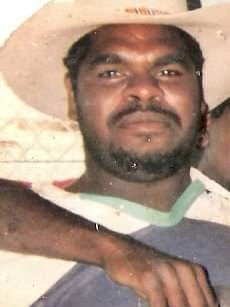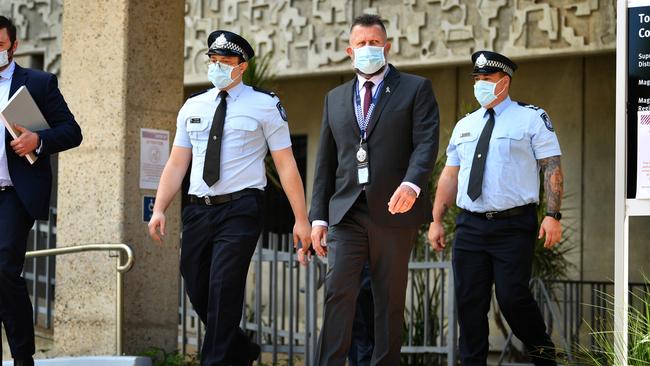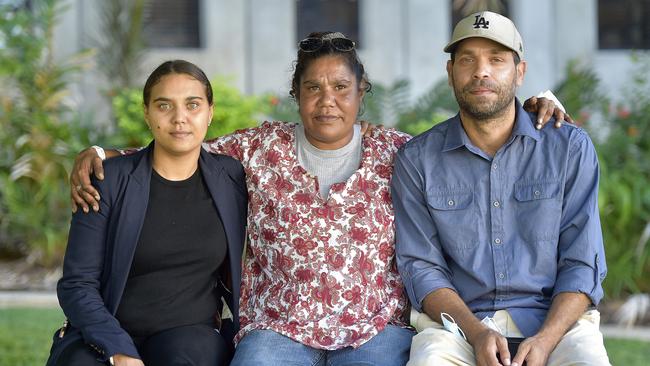Coroner calls for review of neck hold used on Indigenous man before he died
Queensland’s state coroner has called on police to review the use of a controversial neck hold banned across the world after an Indigenous man died in police custody in Townsville.
Townsville
Don't miss out on the headlines from Townsville. Followed categories will be added to My News.
Queensland’s state coroner has called on police to review the use of a controversial neck hold banned in jurisdictions across the world.
Coroner Terry Ryan made the recommendation in inquest findings into the death of a Aboriginal man from Townsville who died after he was forcefully restrained by police for an emergency mental health evaluation in 2018.
Trevor King, 39, known culturally as Noomba died outside his Pankina St home in front of his children after what Mr Ryan classified as a “violent confrontation” with police.
Noomba’s partner of more than 10 years called Triple-0 out of concern for his safety after she found him sniffing petrol and talking of suicide.
In his findings, Mr Ryan said Noomba became unresponsive while handcuffed on the ground but said his deteriorating condition was not noticed until after he was put into an ambulance, unresponsive, more than eight minutes after paramedics arrived.

Mr Ryan concluded responding paramedics failed to conduct a basic assessment of Noomba’s vital signs leading to a delay in detecting his cardiac arrest. Even after it was identified, Mr Ryan said the level of treatment Noomba received was “suboptimal”.
“I recommend that the Queensland Police Service review the inclusion and training of Lateral Vascular Neck Restraint (LVNR) in the situational use of force model,” Mr Ryan said in his findings.
He noted “conflicting views” about the restraint, which involves the compression of arteries and veins in the neck to decrease blood supply to the brain, and its place in modern policing.
Police officers in Queensland are permitted to use the restraint but the police manual states officers should not use it unless an incident is high risk and there is an immediate operational necessity or, if they are acting or aiding in self-defence.
At the inquest held in Townsville in early April 2021 responding police officer Constable Zachary Schembri was one of 12 witnesses to give evidence.
He denied using the LVRN despite initially telling investigators he used an action “like the LVNR” and put his arm around the neck and collarbone area of Noomba before dropping his weight to bring him to the ground.
His body-worn camera captured the moments he and another officer restrained Noomba and the three of them fell to the ground.
Despite recommending the QPS review its use of the LVNR, Mr Ryan accepted the junior police officer did not employ the restraint and instead used a similar motion without actual restriction of the neck or arteries.
Former Victoria Police Assistant Commissioner Emmett Dunne was consulted about police actions that night.

Mr Dunne said the quality of the body-worn camera footage made it hard to comment on how Noomba was restrained while on the ground but concluded police actions were reasonable.
Despite this, Mr Dunne was of the opinion a LVNR or any restraint designed
to restrict blood flow to the brain should not be used unless in a “fight for your life” situation.
Ultimately, Mr Ryan concluded Noomba died after he was restrained by police and classified his cause of death as cardiac arrest in a person with a severe pre-existing heart condition who was restrained and had consumed volatile hydrocarbons.
“(Body-worn camera) footage demonstrated that the paramedics failed to
undertake any meaningful assessment of Noomba on the roadside,” Mr Ryan said.
“It was also apparent that there was no urgency from police or paramedics in a situation where Noomba was critically unwell.”
In his findings, Mr Ryan said Noomba’s death highlighted issues in communication between responding police and paramedics.
He noted confusion about whether the QPS or QAS has primary responsibility for Noomba’s care.
Police assumed paramedics assumed control following a briefing but paramedics gave evidence they believed police remained in control as they had Noomba in custody.

He made a further recommendation the QPS make it mandatory for officers to request a priority medical assessment for a person in custody whose demeanour rapidly declines from a state of heightened emotion and agitation to one of apparent compliance – like Noomba.
Mr Ryan also made a recommendation to the Queensland Government worth health services and First Nations peoples in Townsville and North Queensland to develop culturally appropriate referral pathways for Indigenous people in mental health crises as an alternative to assessment in hospital emergency departments.
“On the night of his death, Noomba was a man whose distress was closely related to his perceptions of a loss of connection to culture, “ Mr Ryan said.
“The family also expressed concern that the presence of police officers who use force to take persons into custody has the potential to result in the escalation of a confrontation.
“While the attending police officers may have been well intentioned in their efforts to take Noomba to hospital, it was inevitable that they would struggle to communicate effectively with Noomba about those issues.”
Readers seeking support can contact Lifeline crisis support on 13 11 14, visit lifeline.org.au. Resources for young Aboriginal and Torres Strait Islanders can be found at Headspace: Yarn Safe
More Coverage
Originally published as Coroner calls for review of neck hold used on Indigenous man before he died




